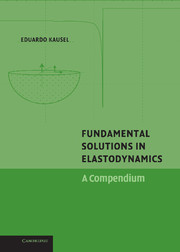Book contents
- Frontmatter
- Contents
- Preface
- SECTION I PRELIMINARIES
- SECTION II FULL SPACE PROBLEMS
- SECTION III HALF-SPACE PROBLEMS
- SECTION IV PLATES AND STRATA
- SECTION V ANALYTICAL AND NUMERICAL METHODS
- Read me first
- 8 Solution to the Helmholtz and wave equations
- 9 Integral transform method
- 10 Stiffness matrix method for layered media
- SECTION VI APPENDICES
10 - Stiffness matrix method for layered media
Published online by Cambridge University Press: 12 January 2010
- Frontmatter
- Contents
- Preface
- SECTION I PRELIMINARIES
- SECTION II FULL SPACE PROBLEMS
- SECTION III HALF-SPACE PROBLEMS
- SECTION IV PLATES AND STRATA
- SECTION V ANALYTICAL AND NUMERICAL METHODS
- Read me first
- 8 Solution to the Helmholtz and wave equations
- 9 Integral transform method
- 10 Stiffness matrix method for layered media
- SECTION VI APPENDICES
Summary
Closed-form solutions for layered media, or for homogeneous plates and strata with arbitrary boundary conditions, do not exist. Indeed, even the free–free plate – the so-called Mindlin plate – is ultimately intractable by purely analytical means. Thus, such problems must be solved with the aid of numerical tools. Among these, a widely used scheme is the propagator matrix or transfer matrix method of Haskell and Thomson. Nonetheless, we choose instead to present herein the related stiffness or impedance matrix method, which has the advantages over the propagator matrix method that are listed below and, at least in our judgment, no disadvantages in comparison with the latter. Thus, readers familiar with the propagator method are strongly encouraged to familiarize themselves with and switch to this superior method. Among the advantages of the stiffness matrix method are:
Stiffness matrices are symmetric, while propagator matrices are not.
Stiffness matrices involve half as many degrees of freedom as propagator matrices, so their bandwidth is only half as large. The former involve only displacements, whereas the state vector in propagator matrices contains both stresses and displacements.
On account of the two previous items, the stiffness matrix method is nearly an order of magnitude faster than the propagator matrix method: The computational effort is smaller by a factor 2 due to symmetry, and a factor of more than 4 on account of bandwidth, which gives a total reduction of more than 8. Since the computations must be repeated for each frequency and each wavenumber, the savings are considerable.
[…]
- Type
- Chapter
- Information
- Fundamental Solutions in ElastodynamicsA Compendium, pp. 140 - 184Publisher: Cambridge University PressPrint publication year: 2006



